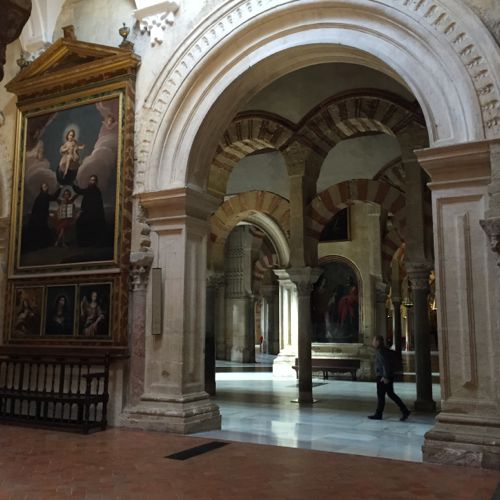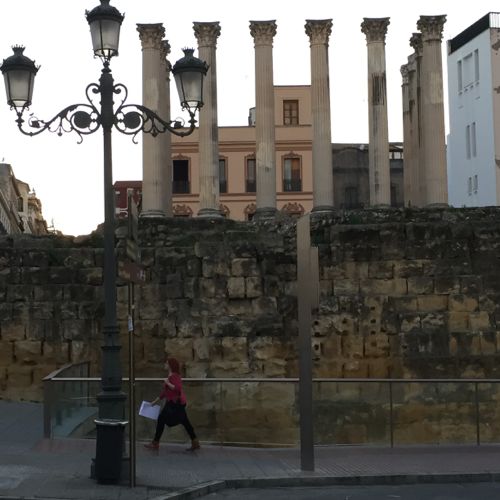THE SENSE OF DISCOVERY while traveling is always greatest when one has never been to a place before, or heard anything about it, or even seen pictures of it. For me, Zaragoza, heart of Spain’s Aragon province, was such a place.
Again, my visit was a 24-hour whirlwind – just about long enough to get a sense of the city. My train from Cordoba passed first through green hills, then brown flatlands, before arriving at Zaragoza’s brutally modern Delicias station, above, about 7PM. Zaragoza prides itself on its avant garde architecture, but I seem to gravitate to the oldest part of any city, often narrow, crooked streets, usually on a river.
In Zaragoza, the river is the Ebro; its Renaissance Basilica del Pilar, below, is the chief monument that gives the skyline its dignified character. (There are Goyas inside; I missed them.)
Surprisingly, I also found ‘modernismo’ in Zaragoza — Art Nouveau-inspired, very early 20th century modernism, of which my hotel, Catalonia el Pilar, below, is a fine example. As in Madrid, my renovated room was cold and dull in contrast to the building’s sumptuous original detail – a lost opportunity, or simply what sells in the Eurozone?
Lobby detail, Hotel Catalonia el Pilar, below.
Another early-modernist building: the majestic iron 1903 produce market hall, above.
Lovely folks at reception sent me to the neighborhood known as El Tubo in search of sustenance. That’s Zaragoza’s lively tapas district. I was early – it was barely 8PM – so had no troubling finding space to stand at the bar at Bodegas Almau, below, where I ordered a few tapas and a glass of vino tinto. I can’t say that bread with cheese and jam, plus a fried fish ball, some tuna on bread, and a plate of olives made for an elegant dinner, but I loved the atmosphere of the place, particularly as it filled up with a mixed-age crowd.
Bodegas Almau is one of dozens of tapas and wine bars in a warren of ancient streets. To get there, I walked along Calle Alfonso, below, a pedestrian-only passage lined with what I’ve already come to think of as “the usual” chain shops and a couple of historic cafés. The shops were brightly lit and busy, the street hopping. Even elderly people with canes and walkers were out and about as I headed back to the hotel about 10PM for a good long sleep.
Zaragoza in the morning was crisp and clear (weather in the 50s, rain jacket as yet unpacked). My goal was to visit sites associated with the important Roman settlement (the name Zaragoza comes from Caesar Augustus). There are four: the forum, baths, port and theatre. The Foro museum, below, was closed, and the port and baths back in the direction from which I had just come.
I spent time instead at the excavated site of the 1st century amphitheater, Zaragoza’s best preserved Roman monument, and its excellent museum, opened in 2003. The impressively large structure, below, under a modern sunshade, was actually just discovered in the 1970s.
The theatre, several stories tall, was used for over 200 years, mainly for stage entertainment and not gladiatorial contests. It had been partly demolished eons ago, the stones re-purposed for fortifications during the Middle Ages. Then it was buried beneath the Moorish city and later, the Christian, with churches that came and went, all on the same site. This was also the location, I was fascinated to learn, of part of the Jewish quarter (or ghetto – though the word wasn’t used in the museum, the Jewish quarter, as elsewhere in Europe, was separated from Christian residential areas by a high wall, with a gate that was locked at night). There were two synagogues in that same area (of a total of six in Zaragoza by the end of the 14th century), before mass conversions of the Jews and their final expulsion from the Iberian peninsula in 1492.
I looked at old coins and stones and pots, and found some lunch at an old-fashioned café on Calle Alfonso. Then I headed by taxi back to Estazione Delicias, where I sprang for a first-class reservation (only 4 euros more this time) for the four-hour trip to Perpignan. Below, train-station tapas.
Spain, adios. France, je viens.
































































































